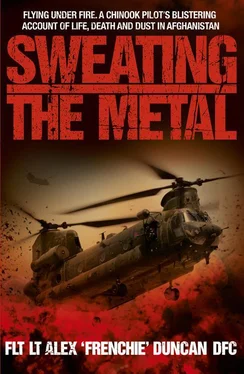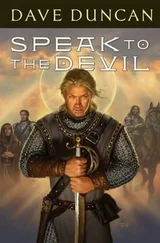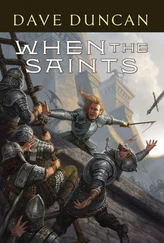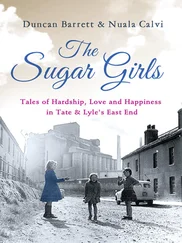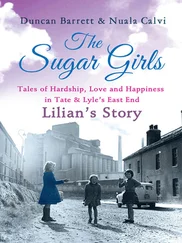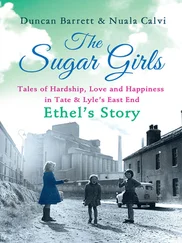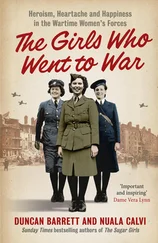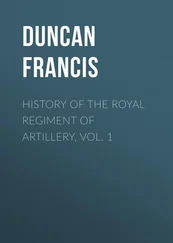I was really quite in awe as I stood before her. Aside from anything else she might represent, the Queen is a piece of living history who, as I write, has given weekly audiences to twelve British Prime Ministers right the way back to Sir Winston Churchill. I found that difficult to get my head around – the things she must have seen. So many icons through history, and she has had personal relationships with all of them. Notwithstanding that, the Queen is a consummate professional and she put me at ease without my even noticing she’d done so. She starts by asking a benign question to relax you, because she’s been doing it long enough now to know that everyone is nervous before her.
She asked me about flying and how things were in Afghanistan and then she said, ‘So tell me exactly what happened,’ so I told her the story.
‘And how is Governor Mangal?’
‘Well Ma’am, he’s fine now, but he did make me laugh. Even though he’d just survived an assassination attempt, his only concern when I landed at FOB Edinburgh was to find the bed Prince Harry had slept in!’ That actually made her grin.
I knew I’d been with her for a while by this stage and I could feel the conversation wrapping up, but just in case you miss the subtle cue, she does this thing where she puts her hand in yours to shake it and you almost sense, rather than feel, the gentlest of pushes. I took a step back, bowed and walked away.
Alison and I now have our own videos of our time with the Queen. Her conversation lasts forty-one seconds, but it’s not really important that mine lasted one minute and thirty-two seconds! Ali doesn’t find that funny for some reason…
After the ceremony, I was approached by Squadron Leader Andrew Calame, the Queen’s equerry, who said, ‘Ah, you’re the chap who took the rocket through the back of your aircraft. The Queen and Prince Philip were laughing at something you said in the report of the incident they were reading at breakfast this morning.’
That is another reason why the military holds the Queen in such affection – she has a genuine interest and goes out of her way to read up on any soldiers, sailors or airmen to whom she is giving awards, and she really drills down into the detail. In any case, it was a nice thought to go away with – that she and Prince Philip had been talking about me at breakfast that morning!
It was only later when I looked at the medal after the ceremony that I noticed the thumb print on its face. It was pristine when the Queen lifted it to pin it on my chest and I noticed that her thumb was on the centre of the cross as she placed it, but didn’t think anything of it. I never touched it myself, and then I noticed the slight discoloration where the print was. That’s when it dawned on me that it belonged to the Queen.
It’s still there, even now.
PART FOUR
THE CRUCIBLE OF FIRE
38
FORTUNE BY NAME, FORTUNE BY NATURE
The year of 2009 turned out to be the bloodiest year of all for British Forces in Helmand Province, with the violence the worst it had been since the Taliban was removed from power in 2001. A total of 108 British soldiers died between January and December.
One of the biggest evolutions to take place that year was the increase in the use of remotely-detonated explosive devices, which were being used to target foreign forces across the country. Around 80% of British deaths in 2009 were as a result of IED explosions, evidencing a change of tactics by the Taliban, who suffered extensive losses in conventional firefights against the better-trained and equipped British and US forces. According to figures from iCasualties.org, ISAF deaths attributed to IEDs rose from 41 in 2006 to 368 in 2010 – an increase of almost 900%.
Predictably perhaps, the knock-on effects were felt by the Chinook Force too, as the tempo of operations increased and the IRT flew more missions than ever. As 2010 rolled around, changes were made to the set-up at Camp Bastion to improve response times; the crews for the IRT cab, the MERT and those Apaches providing the escort, moved to dedicated accommodation just yards from the pan, meaning the aircraft were now just a few steps from the JOC and their tents.
There were other changes, too. US President Barack Obama announced his long-awaited strategy for Afghanistan and deployed a further 30,000 troops to supplement the 70,000 soldiers already in theatre. Britain, already the second largest provider of troops to the region, sent a further 1,200, taking the total number to 9,500 with the vast bulk – 6,200 – in Helmand Province.
At a more local level, JHF (A) integrated into the US 3rd Marine Aviation Wing, part of the 1st Marine Expeditionary Force, a logical and tactical step forward in terms of US and UK helicopters working alongside each other within the new region of RC Southwest. The old RC South was divided along provincial lines: RC Southwest (Helmand Province) and RC Southeast (Kandahar Province).
The pressure on the Chinook Force was alleviated to a degree by an increase in frames; by 2010, we had nine Chinooks in theatre; ten Apaches; four Lynx; four Sea Kings and a total of six Merlins. In addition, the organisation and effectiveness of the IRT was enhanced by the addition of two US Army HH-60 Pedro Black Hawk ‘Dust-offs’ on call alongside the Chinooks. RAF Fast Air Support was now supplied by Tornado GR-4s which replaced the Harrier GR-7s and GR-9s that had fulfilled that role from the beginning.
While I was busy training the next generation of Chinook crews back in the UK, my colleagues from previous Dets were back out in theatre flying under fire and making the headlines. Flt Lt Ian ‘Chomper’ Fortune, who flew as JP’s co-pilot on Operation Oqab Sturga in 2008, was fortunate to escape with his life in January after coming under heavy, sustained fire on an IRT mission, a sortie for which he was later awarded a well-deserved DFC for some outstanding leadership and inspirational flying under the most testing conditions. His actions also attracted the attention of GAPAN, which awarded him its Grand Master’s Commendation for 2009/10, and December 2010’s The Sun Military Awards, at which he received the Most Outstanding Airman award. Ian’s aircraft came under sustained fire by the Taliban and was hit a total of eight times, resulting in a series of system failures including damage to the flight stabilisation system and forward transmission. Ian was also hit – the first time in the nine-year war that a pilot has been shot while in the air.
The cab that he was flying – ZA718, better known by her squadron code Bravo November (BN) – is interesting in and of itself. One of the original batch of thirty-three Chinook HC2s delivered to the Royal Air Force in early 1982, she’s seen action in every major operation involving the RAF in the helicopter’s almost thirty-year service life. She was one of four Chinooks that travelled to the Falkland Islands on the Atlantic Conveyor which was sunk with the loss of all its cargo. It was struck by two Exocet missiles while waiting to offload at San Carlos Water. By chance, BN was airborne on an engineering test flight at the time of the attack and was diverted to HMS Hermes .
As the only helicopter available in the Falkland Islands, she then had to endure a punishing flying programme without spares, tools or appropriate lubricants for several weeks, in appalling weather conditions. On one particular mission, BN ran into a blizzard on her way to San Carlos Water and crashed into the sea at 100 knots. Despite water swamping the cockpit and engines, she still managed to get airborne again due to the bravery of pilot Richard Langworthy, who was awarded the DFC. The cab would go on to see two more of her pilots awarded the Distinguished Flying Cross for actions while in command of BN by 2010; Ian Fortune was the third. Ian and I met up not long after he returned from theatre, when he told me his story:
Читать дальше
